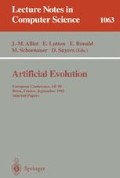Abstract
In this paper, we study the coevolution of species by combining a theoretical approach with a computer simulation in order to show how a discrete distribution of viable species emerges. Coevolution is modelled as a replicator system which, with an additional diffusion term representing the mutation, leads to a Schrödinger equation. This system dynamics can be interpreted as a survival race between species on a multimodal sinking and drifting landscape whose modes correspond to the eigen modes of the Schrödinger equation. This coevolution dynamics is further illustrated by a simulation based on a continuous phenotypic model due to Kaneko in which the interactions between species are interpreted through a Lotka-Volterra model. This simulated coevolution is seen to converge to viable species associated with a dynamics at the edge of chaos (i.e with a null Lyapounov exponent). The transition from such a viable species to another results from some kind of tunnel effects characteristic of the punctuated equilibrium classically observed in biology in which rapid changes in the species distribution follow long plateaus of stable distribution.
Preview
Unable to display preview. Download preview PDF.
References
J.P. Aubin. Viability Theory. Birkhauser, 1991.
P. Bak. Self-organized criticality. Physica A, 1990.
P. Bak and K. Chen. Self-organized criticality. Scientific American, pages 26–33, January 1991.
P. Bak, H. Flyvbjerg, and B. Lautrup. Coevolution in a rugged fitness landscape. Phys. rev A, 46:6724–6730, November 1992.
R. Feistel and W. Ebeling. Evolution of Complex Systems: Selforganization, Entropy and Development. Kluwer Academic,Dordrecht, 1989.
F.Hoffmeister and T. Báck. Genetic algorithms and evolution strategies: Similarities and differences. Technical report, University of Dortmund, 1992.
H. Flyvbjerg and B. Lautrup. Evolution in a rugged fitness landscape. Phys. rev A, 46:6714–6723, November 1992.
K. Kaneko and J. Suzuki. Evolution to the edge of chaos in an imitation game. In Artificial Life III, 1994.
S. A. Kauffman and S. Johnsen. Co-evolution to the edge of chaos: coupled fitness landscape, poised states and co-evolutionary avalanches. In J. D. Farmer C. G. Langton, C. Taylor and S. Rasmussen, editors, Artificial Life II, Santa Fe, New Mexico, 1991. Addison Wesley.
S.G. Mikhlin. Integral equations. Pergamon Press, 1957.
H.-O. Peitgen, H. Jürgens, and D. Saupe. Chaos and Fractals: New Frontiers of Science. Springer-Verlag, New York, 1992.
M. Peschel and W. Mende. The Predator-Prey Model. Springer-Verlag, Wien, 1986.
H. G. Schuster. Deterministic Chaos: An Introduction. VCH Verlagsgesellschaft, 1989.
V. Volterra. Leçons sur la théorie mathématique de la lutte pour la vie. Herrmann & Cie, Paris, 1931.
Author information
Authors and Affiliations
Editor information
Rights and permissions
Copyright information
© 1996 Springer-Verlag Berlin Heidelberg
About this paper
Cite this paper
Bourgine, P., Snyers, D. (1996). Lotka Volterra coevolution at the edge of chaos. In: Alliot, JM., Lutton, E., Ronald, E., Schoenauer, M., Snyers, D. (eds) Artificial Evolution. AE 1995. Lecture Notes in Computer Science, vol 1063. Springer, Berlin, Heidelberg. https://doi.org/10.1007/3-540-61108-8_35
Download citation
DOI: https://doi.org/10.1007/3-540-61108-8_35
Published:
Publisher Name: Springer, Berlin, Heidelberg
Print ISBN: 978-3-540-61108-0
Online ISBN: 978-3-540-49948-0
eBook Packages: Springer Book Archive

